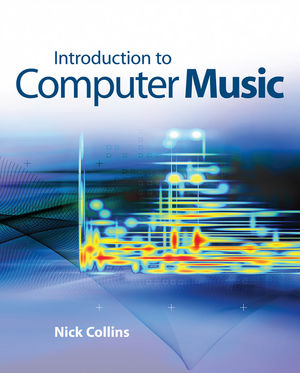|
Textbook
Introduction to Computer MusicISBN: 978-0-470-71455-3
Paperback
400 pages
February 2010, ©2010
 |
||||||
Preface.
Acknowledgments.
1 Introduction.
1.1 What is Computer Music?
1.1.1 Some Examples of Computer Music.
1.1.2 Sociable Computer Musicians.
1.1.3 Why Investigate Computer Music?
1.2 Quickstart Guide to Computer Music.
1.2.1 Sound Waves and the Brain.
1.2.2 The Time Domain.
1.2.3 Periodicity.
1.2.4 The Frequency Domain.
1.2.5 Digital Audio.
1.2.6 Filters.
1.2.7 Timbre.
1.2.8 Space.
1.2.9 Patching, Signal Flow and Unit Generators.
1.2.10 Computer Music Software.
1.2.11 Programming and Computer Music.
1.2.12 Representing Music on a Computer.
1.3 A Whirlwind History of Computer Music.
1.4 Summary.
1.5 Exercises.
1.6 Further Reading.
2 Recording.
2.1 Recording: A History.
2.2 Musical Instrument Digital Interface.
2.3 Virtual Studios.
2.4 File Formats and Audio Codecs.
2.5 Spatialization.
2.5.1 Spatial Hearing and Room Acoustics Primer.
2.5.2 Surround Sound Configurations and Multichannel Formats.
2.6 Recording Tips and Tricks.
2.7 Sampling.
2.7.1 A History of Sampling.
2.7.2 Copyright.
2.7.3 Sample Playback.
2.8 Summary.
2.9 Exercises.
2.10 Further Reading.
3 Analysis.
3.1 Sound Analysis.
3.2 Fourier Analysis and the Phase Vocoder.
3.2.1 Short-time Fourier Transform.
3.2.2 Further Refinements to Fourier Analysis.
3.2.3 Resynthesis after Sinusoidal Modeling.
3.2.4 Not All Sounds are Periodic: Coping with Noise.
3.3 Alternative Representations for Analyzing Sound.
3.4 Auditory Models.
3.4.1 Physiologically Inspired Models of the Auditory System.
3.4.2 Computational Auditory Scene Analysis.
3.4.3 Perceptual Audio Coding.
3.5 Feature Extraction.
3.5.1 Pitch Detection.
3.5.2 Onset Detection.
3.5.3 Beat Tracking.
3.6 The Transcription Problem.
3.7 Machine Listening and Causal Realtime Analysis.
3.8 Summary.
3.9 Exercises.
3.10 Further Reading.
4 Processing.
4.1 More on Signals.
4.1.1 Signals and Sampling Rates.
4.1.2 Ring and Amplitude Modulation.
4.1.3 Mixing and Splicing.
4.1.4 Delays.
4.2 Convolution and Filters.
4.2.1 Impulse Responses and the Convolution Operation.
4.2.2 Convolution and Multiplication.
4.2.3 More on Filters.
4.2.4 Examples: Comb andAll-pass Filters.
4.3 ACompendium of Marvelous Digital Audio Effects.
4.3.1 Dynamics Processing, Distortion and Waveshaping.
4.3.2 Time Stretching and Pitch Shifting.
4.3.3 Implementing Spatialization.
4.4 Summary.
4.5 Exercises.
4.6 Further Reading.
5 Synthesis.
5.1 The Space of Sound SynthesisAlgorithms.
5.1.1 ClassicAlgorithms.
5.1.2 Waveforms and Wavetables.
5.1.3 Frequency Modulation.
5.1.4 Granular Synthesis.
5.1.5 Feature-based Synthesis.
5.2 Physical Modeling.
5.2.1 Waveguide Synthesis.
5.2.2 Singing Voice Synthesis.
5.3 Summary.
5.4 Exercises.
5.5 Further Reading.
6 Interaction.
6.1 Introduction to Interaction.
6.1.1 Defining Interaction.
6.1.2 Directness of Control and the Physicality of Gesture.
6.2 Interfacing.
6.2.1 A Survey of Input Devices.
6.2.2 OfficeComputing forMusic.
6.2.3 Audio and Video Tracking.
6.2.4 Physical Computing.
6.2.5 Physiological State.
6.3 Interaction Scenarios.
6.3.1 Installations.
6.3.2 Computer Games.
6.3.3 Concert Performance.
6.4 LiveMusical Agents.
6.4.1 Automatic Accompaniment.
6.4.2 Robot Musicians.
6.4.3 Programming the 'Brain' of aVirtual Musician.
6.5 Evaluation.
6.6 Summary.
6.7 Exercises.
6.8 Further Reading.
7 Networks.
7.1 Introduction to Networks.
7.1.1 Network Technology.
7.1.2 Network Music and Installations.
7.1.3 Further Network Music Ensembles and the Laptop Orchestra.
7.1.4 Mobile Music.
7.1.5 Online Music Distribution.
7.2 Music Information Retrieval.
7.2.1 Content Analysis.
7.2.2 Annotation and Evaluation.
7.2.3 MIR Deployments.
7.3 Summary.
7.4 Exercises.
7.5 Further Reading.
8 Composition.
8.1 Composers and Computers.
8.1.1 Musical Decisions: TheAct of Composition.
8.1.2 Roles for Computers in Composition.
8.1.3 Computer Music and Musical Style.
8.2 Organizing Sound.
8.2.1 Sound Objects and Parameters.
8.2.2 Pitch.
8.2.3 Timbre.
8.2.4 Space.
8.2.5 Time.
8.2.6 Local Structures.
8.2.7 Musical Form.
8.3 Formalizing Music.
8.3.1 Algorithmic Composition.
8.3.2 Implementing Algorithmic Composition.
8.4 Summary.
8.5 Exercises.
8.6 Further Reading.
9 Modeling.
9.1 TheAct of Modeling.
9.2 Representations.
9.3 Automating Musicological Analysis.
9.4 Modeling of Musical Expression.
9.5 Sonification.
9.6 The Information Characteristics of Music.
9.7 Summary.
9.8 Exercises.
9.9 Further Reading.
10 Conclusions.
10.1 Exercises.
References.
Index.



